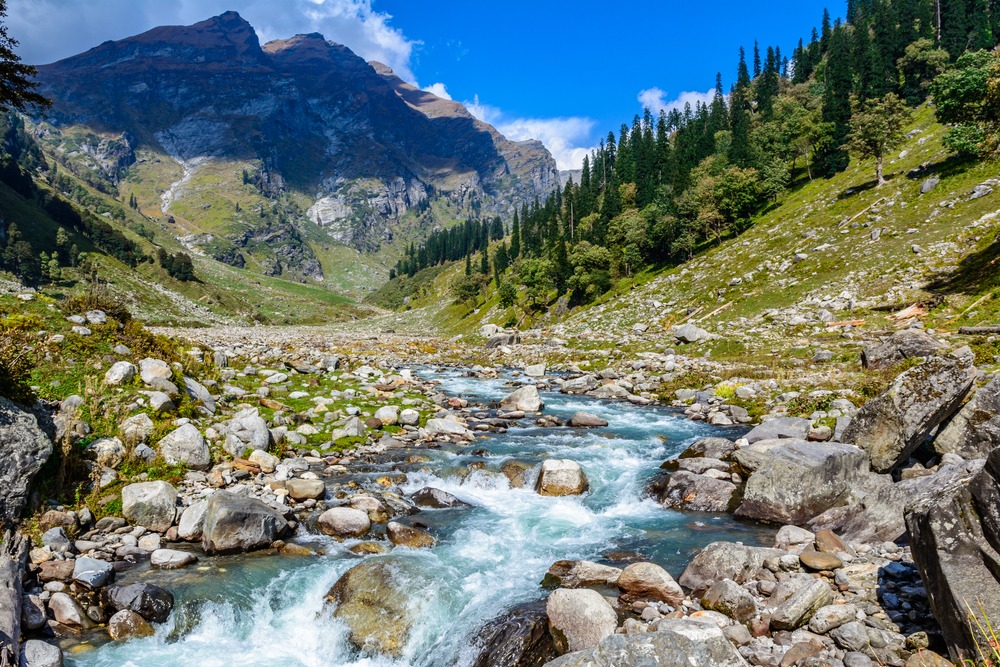Introduction
If there’s one trek that has left an everlasting imprint on my heart, it’s the Hampta Pass trek. Nestled in the breathtaking Pir Panjal range, this trek is a thrilling blend of lush green valleys, snowy landscapes, and barren Spitian deserts. It’s a trek where each step unfolds a new surprise, from towering cliffs to dramatic river crossings. I still remember the moment I stood at the 14,100 ft high Hampta Pass, looking at the surreal transformation of landscapes – it was nothing short of magical.
What makes this trek an absolute must-do for adventure lovers is the perfect balance between challenge and beauty. It’s not just about reaching the top; it’s about experiencing the changing terrains, embracing the high-altitude chill, and soaking in the untouched natural beauty. For those who crave an adventure that offers more than just a walk in the mountains, Hampta Pass is a dream come true.
Where is Hampta Pass Located?
The first question that pops into most people’s minds is – Where exactly is Hampta Pass? Well, let me tell you, it lies in the Pir Panjal range of the Himalayas, bridging the lush Kullu Valley with the starkly different Spiti Valley. This trek offers an extraordinary opportunity to witness two contrasting landscapes within just five days. Located at an altitude of 4,270 meters (14,100 feet), it acts as a natural passage for shepherds moving their livestock from Kullu to Spiti.
The journey to Hampta Pass begins in Manali, a bustling town in Himachal Pradesh. From there, it’s a short drive to Jobra, the trek’s starting point. What I loved about reaching here was how the landscapes kept shifting, one moment you’re in a pine forest, and the next, you’re walking on a rugged mountain trail. It’s truly a geographical wonder, making it an unmissable experience for those who seek adventure in the untamed wilderness.
Best Time to Visit Hampta Pass Trek
Timing is everything when it comes to experiencing the best of Hampta Pass, and trust me, choosing the right season can make all the difference. The ideal months to embark on this adventure are June to September. During this period, the landscapes are at their finest – a mix of snow, greenery, and clear skies.
I trekked in July, and it was a sight to behold. The first half of the trek was filled with green meadows, gushing streams, and vibrant wildflowers, while the second half transformed into a winter wonderland with glistening snowfields. If you’re someone who enjoys walking on fresh snow, June and early July are your best bet. However, if you prefer clearer skies and moderate temperatures, August and September offer stunning views of golden meadows with a distant backdrop of snow-capped peaks.
If you’re planning to embark on the Hampta Pass trek, I highly recommend booking with The Searching Souls. They provide expert guides, comfortable campsites, delicious meals, and a well-organized trekking experience that ensures both safety and adventure. With their experienced team and top-notch support, you’ll be able to enjoy the breathtaking beauty of Hampta Pass without any worries.
How Difficult is the Hampta Pass Trek?
Whenever someone asks me if the Hampta Pass trek is too difficult, my answer is – It depends on your preparation. It is rated as a moderate-level trek, meaning it’s not too easy but also not too extreme. Covering a distance of 35 km in 4-5 days, the trek involves steep climbs, river crossings, and walking on snow, which require decent fitness and stamina.
For me, the most challenging part was the final ascent to the pass. The steep climb on slippery snow and loose rocks tested my endurance, but the view from the top made every step worth it. I’d say, if you’re physically active, you’ll do just fine. Cardio exercises, strength training, and trekking practice can help you build the stamina needed to enjoy this trek without exhaustion.
Scenic Landscapes and Natural Beauty
There are few treks that can match the diverse beauty of Hampta Pass. What struck me the most was how the scenery changed every single day. It starts with lush green forests filled with pine and deodar trees, then moves to open meadows with wildflowers and grazing sheep. As you gain altitude, the greenery vanishes, replaced by rocky trails, glaciers, and snowfields.
But the real surprise? The moment you cross the pass, everything changes in an instant. On one side, you see Kullu Valley’s greenery, and on the other, the barren, moon-like landscapes of Spiti. I stood there, utterly mesmerized by the stark contrast between life and emptiness, warmth and cold, greenery and desert. It’s something I’ll never forget.
Thrilling River Crossings and Snow Bridges
If there’s one thing that added an extra dose of adventure to this trek, it was the multiple river crossings. Trust me, there’s nothing quite like walking through an ice-cold, knee-deep glacial stream, feeling the chill shoot up your spine! The most notable crossing was Rani Nallah, where I had to carefully tread through freezing waters while balancing on slippery rocks.
Another thrilling experience was walking on natural snow bridges. At some points, we had to crawl over thin sheets of ice, knowing that a gushing stream flowed right underneath. It was simultaneously thrilling and horrifying! But these challenges are what make the trek so memorable. Every river crossing, every step on fragile snow, makes you feel alive and connected to nature in a way that’s hard to describe.
The Mesmerizing Chandratal Lake
No Hampta Pass trek is complete without a visit to the breathtaking Chandratal Lake. Located at 14,100 feet, this crescent-shaped, turquoise-blue lake is one of the most magical sights in Spiti Valley. I remember the first time I saw it – I was speechless. The color of the lake kept changing from blue to green to purple as the sun moved across the sky.
Chandratal is not just a lake; it’s an emotion. Sitting by its banks, staring at the reflection of the towering peaks in its crystal-clear waters, I felt a sense of peace that I had never experienced before. No matter how tired you are after the trek, the beauty of this lake rejuvenates you instantly. If there’s one place I’d urge every adventure lover to visit, it’s Chandratal.
Camping Experience Under the Stars
There’s something truly magical about camping in the Himalayas, and Hampta Pass offers some of the most surreal campsites I’ve ever experienced. Imagine lying inside your tent, wrapped in a warm sleeping bag, gazing at a sky full of stars with the sound of a river flowing nearby. That’s exactly what camping at Balu Ka Ghera, Shea Goru, and Chhatru felt like.
One night, I stepped out of my tent at Shea Goru, and what I saw took my breath away – the entire Milky Way stretched across the sky, with shooting stars flashing every few minutes. In that moment, I felt tiny yet infinite, a part of something far greater than myself. It’s moments like these that make trekking such a life-changing experience.
Rich Flora and Fauna on the Trail
One of the most beautiful aspects of the Hampta Pass trek is the rich biodiversity that unfolds along the trail. As I hiked through the dense forests of Jobra, I was greeted by towering pine, deodar, and oak trees, their scent filling the fresh mountain air. The trail was lined with vibrant wildflowers, including rhododendrons, blue poppies, and Himalayan daisies, adding a splash of color to the lush greenery. It felt as if I was walking through a painting, where every shade of green was complemented by the bright hues of blooming flowers.
But what truly fascinated me was the wildlife that thrived in these remote landscapes. I was lucky enough to spot a Himalayan Marmot, a furry little creature sunbathing on a rock, and a few blue sheep (Bharal) gracefully navigating the steep slopes. The rarest and most exciting possibility was encountering a snow leopard, though sightings are extremely rare. I was also enchanted by the sight of the Himalayan Monal, India’s national bird, its iridescent feathers shimmering in the sunlight. It reminded me how special and untouched this part of the world truly is.
Cultural and Local Experiences
While the trek is mainly about nature, the local culture and traditions add an incredible depth to the experience. One of the most memorable moments of my journey was meeting the Gaddi shepherds, who migrate through the Hampta Pass every year with their herds of sheep and goats. I was fascinated by their simple yet resilient way of life, living in the mountains, following ancient migration routes, and adapting to the harsh terrain with ease. Their warm smiles and stories of survival in the wild made me appreciate their deep connection with nature.
Another cultural highlight of the trek was experiencing the Buddhist influence in Spiti Valley. Once I crossed over to the other side of the pass, prayer flags fluttered in the wind, and I could feel the spiritual energy of the place. The monasteries, prayer wheels, and mani stones along the way were a testament to the deep-rooted Tibetan Buddhist culture in this region. It was a beautiful contrast—starting the trek amidst the Hindu traditions of Kullu Valley and ending in the Buddhist realm of Spiti. The people here live with immense peace and harmony, and being a part of it, even for a short while, was a truly humbling experience.
Essential Packing List for Hampta Pass Trek
Packing for Hampta Pass requires careful planning because the weather and terrain keep changing drastically. I learned this the hard way when I underestimated the cold and found myself shivering at Balu Ka Ghera despite wearing multiple layers.
Must-Have Clothing and Gear
- Base Layers – Moisture-wicking thermals for warmth.
- Insulation Layer – A good fleece or down jacket to combat the cold.
- Outer Shell – A waterproof and windproof jacket to protect against unpredictable mountain weather.
- Trekking Pants – Comfortable, quick-dry pants for long walks.
- Trekking Boots – Waterproof, high-ankle boots with strong grip (very important!).
- Woolen Socks and Gloves – Keep extremities warm.
- Backpack (40-50L) – Lightweight and sturdy with rain cover.
Other Essentials
- Sunglasses & Sunscreen – The high-altitude sun is brutal.
- Trekking Poles – Help immensely during steep ascents and descents.
- Energy Snacks – Dry fruits, chocolates, and protein bars for quick energy boosts.
- Hydration Bladder or Bottle – Staying hydrated prevents altitude sickness.
- First-Aid Kit – Includes personal medication, bandages, painkillers, and Diamox for altitude sickness.
Packing smartly and lightly can make or break your trekking experience. Trust me, carrying unnecessary weight on an uphill climb is the last thing you want to do!
How to Prepare for the Trek
Before setting off on the trek, I spent a few weeks preparing my body and mind for the adventure ahead. While Hampta Pass is considered a moderate trek, it does involve steep climbs, river crossings, and long hours of walking. Endurance, strength, and mental resilience are key to making the journey enjoyable rather than exhausting.
Physical Training
To get trekking-ready, I focused on:
- Cardio Workouts – Running, swimming, and cycling to build stamina.
- Leg Strength Exercises – Squats, lunges, and step-ups to prepare for uphill climbs.
- Back and Shoulder Strengthening – Since you’ll be carrying a backpack, these muscles need to be strong.
Acclimatization Tips
One of the biggest concerns during high-altitude treks is altitude sickness. The best way to prevent it is to acclimatize properly. I spent two days in Manali before starting the trek, allowing my body to adjust to the lower oxygen levels. Hydration, slow climbing, and proper breathing techniques helped me avoid altitude-related issues. I highly recommend drinking 3-4 liters of water daily and avoiding alcohol before the trek.
Things to Keep in Mind for a Safe Trek
Safety should always be a top priority, especially when trekking in high-altitude regions like Hampta Pass. I made sure to take all necessary precautions so that I could enjoy the trek without unnecessary risks.
Key Safety Tips
- Check Weather Conditions – Always be aware of possible snowstorms or heavy rainfall.
- Follow Your Guide’s Instructions – Their experience can be life-saving in difficult situations.
- Carry Emergency Medications – Basic first-aid, altitude sickness medicine, and pain relievers are essential.
- Trek Slowly & Steadily – Rushing can lead to exhaustion or altitude sickness.
Having the right information and preparation makes the trek not only safe but also much more enjoyable.
Budget and Cost of Hampta Pass Trek
One of the best things about Hampta Pass is that it’s budget-friendly compared to other Himalayan treks. Here’s a rough breakdown of costs:
- Trek Package (Including Guide, Food & Stay) – ₹8,000 – ₹15,000
- Transportation (Delhi to Manali & Back) – ₹3,000 – ₹5,000
- Food & Miscellaneous Expenses – ₹2,000 – ₹3,000
Total Estimated Cost: ₹12,000 – ₹20,000 ($150 – $250) for a 5-day trek.
For budget travelers, joining group treks or choosing off-season months can significantly cut costs.
Why Hampta Pass is a Bucket-List Trek
Hampta Pass is more than just a trek – it’s an adventure of a lifetime. The landscapes, the challenges, the people, and the emotions make it an unforgettable journey. There’s something indescribable about standing at the top of the pass, looking at the stark contrast between Kullu and Spiti, realizing how small yet how alive we truly are.
For adventure lovers, this trek is a must. It has just the right mix of beauty, thrill, and cultural experience that makes it perfect for those seeking something beyond the ordinary. If you’re looking for a trek that will leave a mark on your soul, Hampta Pass is the one.
Conclusion
Trekking to Hampta Pass is not just about reaching a destination; it’s about the journey, the experiences, and the transformation. Whether it’s crossing gushing rivers, camping under a starlit sky, or standing in awe of nature’s contrasts, every moment on this trek is pure magic. If you love adventure, don’t just dream about Hampta Pass—go and experience it for yourself.








